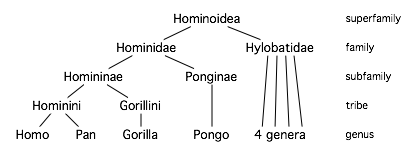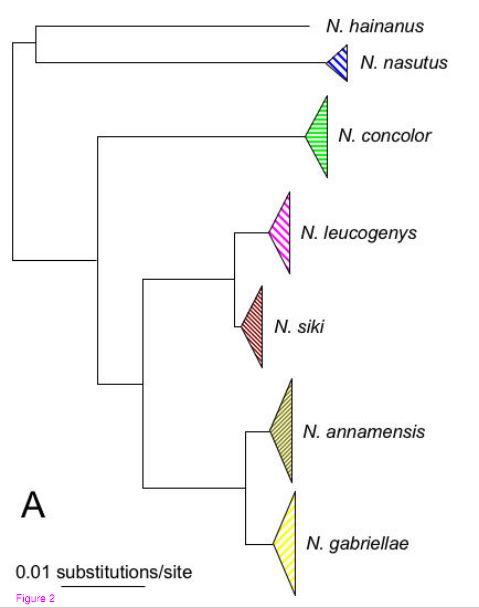Classification
Domain: Eukarya
Kingdom: Animalia
Phylum: Chordata (Subphylum: gnathostomata)
Class: Mammalia (Super Class: tetrapoda)
Order: Primates
Family: Hylobatidae
Genus: Nomascus
Species: N. hainanus
(Wikipedia 2014)
The meaning of Nomascus hainanus is the Black Crested Gibbon (Thinh Biol 2010).
The gibbon species vary drastically throughought their evolutionary tree. The cause can be from various factors. The gibbons originally were diverse throughout the eastern world but are now restricted to Yunnan and Hainan Island (Wang and Poirier 1988), which can allow for greater genetic drift and evolution into new subspecies.
Gibbons have been through a long journey in the evolutionary process. They originally branched off of the bacteria along with archaea to become a eukarya from being multicellular. Click here or here to learn about more eukaryotes. Gibbons then became part of the opisthokonta clade by evolving to have reproductive cells with single flagellum at the base of the body and from there they reached the animal kingdom, which also includes the Carybdea alata (click here to learn more about them). Another organism included in the animal kingdom is the Dracunculua medinensis, which can be found by clicking here. From the animal kingdom they became integrated into the chordate phylum. To be in the chordate phylum, the gibbons acquired true tissue, became triploblastic, became a dueterostomes, and developed a notochord. Click here or here to find out more about other chordates. From the chordate phylum, the gibbons break down into the vertebrata group. They then are brought into the subphylum gnathostomata and the super-class tetrapoda. Gibbons then evolved into the mammal class (BIOZOOM 2013). Also included in the mammalian class is the Panthera tigris, which can be found here, and the Choloepus didactylus (more can be learned about them here).
The gibbons are included in the mammalian class because they have developed hair, mammary glands, and middle ear bones for hearing improvements (Mammalia 2005).
Figure 2. This image shows the classification of the Nomascus hainanus all the way to the genus. Our organism falls into the hylobatidae family. From Wikipedia 2014.
The gibbons’ phylogenic tree is still in controversy. Currently,
the gibbons are in a single genus of Hylobates and they are
split up further in subgenera of Hoolock, Hylobates,
Symphalangus, and Nomascus (Thinh Biol 2010). The
Nomascus
hainaus is included in the subgenera of the Nomascus. To be
considered a part of this genera, the organism must have certain
morphological differeneces that are specific to the Hylobates.
There is a slight coloration difference, including the males
being black and the females being either yellow, orange, or
beige (Thinh Biol 2010).
The main species that gibbons contain are the H. hoolock,
H.
lar, H. leucogenys, and the H. concolor (Wang and Poirier 1988).
The Nonascus hainaus are included in the H. concolor along with
three other subspecies. The subspecies that are from the H.
concolor include the H. c. concolor, H. c. jingdongensis, H. c.
furvogaster, and the H. c. hainaus (Wang and Poirier 1988).
To be considered in the N. nomascus there are acoustic
and chromosomal diffrences. The acoustic songs that all
gibbons participate in are species speceific. There is a
mitochondrail difference in the mitchondrial B, which is
specific to each gibbon species (Thinh Biol 2010).
Figure 3. This is a representation of the phylogeny of the gibbons. The Nomascus hainanus falls into the N. hainanus. From Thinh 2011.
Click here to learn about the next topic of where this organism is found or return to the homepage.

